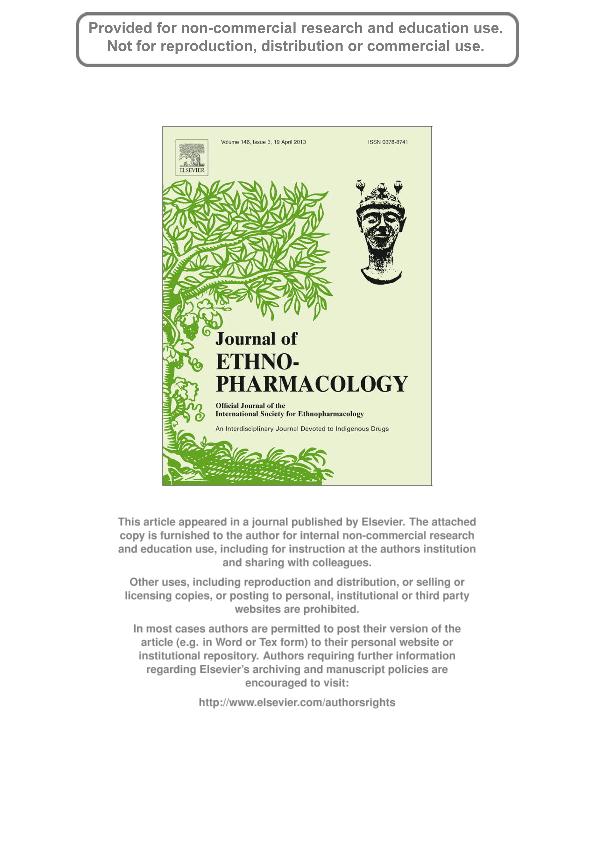Mostrar el registro sencillo del ítem
dc.contributor.author
De medeiros, Patricia Muñiz
dc.contributor.author
Ladio, Ana Haydee

dc.contributor.author
Santos,André Mauricio Melo
dc.contributor.author
de Albuquerque, Ulysses Paulino
dc.date.available
2016-07-22T19:48:36Z
dc.date.issued
2013-03
dc.identifier.citation
De medeiros, Patricia Muñiz; Ladio, Ana Haydee; Santos,André Mauricio Melo; de Albuquerque, Ulysses Paulino ; Does the selection of medicinal plants for Brazilian local populations suffer taxonomic influence?; Elsevier Ireland; Journal of Ethnopharmacology; 146; 3; 3-2013; 842-852
dc.identifier.issn
0378-8741
dc.identifier.uri
http://hdl.handle.net/11336/6647
dc.description.abstract
Ethnopharmacological relevance: The analysis of the influence of taxonomic affiliation on the selection of medicinal plants by Brazilian local populations can help elucidate theoretical aspects of medicinal plant selection. Materials and methods: Ethnobotanical medicinal plant studies were compiled and the resulting medicinal flora was compared to the total angiosperm flora with a Bayesian approach and the IDM model. Results: A total of 35 families were considered to be overused and six were classified as underused for the Bayesian approach. On the other hand, the IDM model considered 13 families as overused and five as underused (all of them were also highlighted by the Bayesian approach). A high overuse level of Bixaceae, Amaranthaceae, Anacardiaceae and Smilacaceae was recorded for both Bayesian and IDM model, while Orchidaceae, Melastomataceae, Eriocaulaceae, Poaceae and Bromeliaceae were considered as underused for both analyses. The most dissimilar body system in terms of family composition was ‘mental and behavioral disorders’. It was also found that the body systems are different from one another in the proportion of taxonomic groups, which could indicate chemical specificity in the treatment of diseases. Conclusions: Results indicate that the chemical specificity of taxonomic groups directly influences medicinal plant selection. Moreover, when data presented here are compared to other studies, there is clearly an overuse pattern for families like Lamiaceae, Rosaceae and Euphorbiaceae and an underuse pattern for Poaceae and Orchidaceae.
dc.format
application/pdf
dc.language.iso
eng
dc.publisher
Elsevier Ireland

dc.rights
info:eu-repo/semantics/openAccess
dc.rights.uri
https://creativecommons.org/licenses/by-nc-nd/2.5/ar/
dc.subject
Etnomedicine
dc.subject
Traditional Medicine
dc.subject
Medicinal Plant Selection
dc.subject
Brazil
dc.subject.classification
Farmacología y Farmacia

dc.subject.classification
Medicina Básica

dc.subject.classification
CIENCIAS MÉDICAS Y DE LA SALUD

dc.title
Does the selection of medicinal plants for Brazilian local populations suffer taxonomic influence?
dc.type
info:eu-repo/semantics/article
dc.type
info:ar-repo/semantics/artículo
dc.type
info:eu-repo/semantics/publishedVersion
dc.date.updated
2016-07-22T18:51:22Z
dc.journal.volume
146
dc.journal.number
3
dc.journal.pagination
842-852
dc.journal.pais
Irlanda

dc.journal.ciudad
Shannon
dc.description.fil
Fil: De medeiros, Patricia Muñiz. Universidade Federal Rural Pernambuco; Brasil. Universidade Federal Da Bahia. Instituto de Biologia; Brasil
dc.description.fil
Fil: Ladio, Ana Haydee. Consejo Nacional de Investigaciones Científicas y Técnicas. Centro Científico Tecnológico Patagonia Norte. Instituto de Investigación En Biodiversidad y Medioambiente; Argentina
dc.description.fil
Fil: Santos,André Mauricio Melo. Universidade Federal Rural Pernambuco; Brasil
dc.description.fil
Fil: de Albuquerque, Ulysses Paulino . Universidade Federal Rural Pernambuco; Brasil
dc.journal.title
Journal of Ethnopharmacology

dc.relation.alternativeid
info:eu-repo/semantics/altIdentifier/url/http://www.sciencedirect.com/science/article/pii/S0378874113001074
dc.relation.alternativeid
info:eu-repo/semantics/altIdentifier/doi/10.1016/j.jep.2013.02.013
dc.relation.alternativeid
info:eu-repo/semantics/altIdentifier/doi/http://dx.doi.org/10.1016/j.jep.2013.02.013
Archivos asociados
